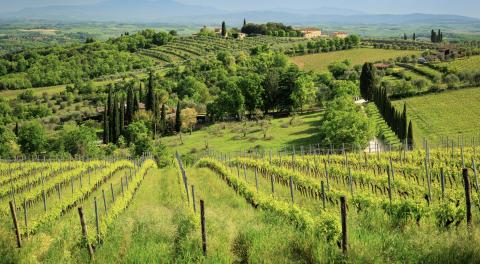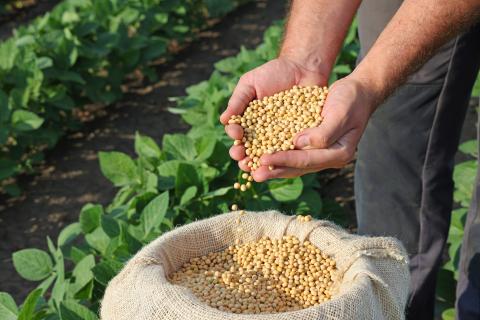A regenerative farming revolution is coming to Italy
While farmers in the US, Brazil, Argentina, and Russia have already adopted practices that leave millions of hectares unploughed, many of their European counterparts continue to rely on traditional, intensive methods that degrade the soil.
This may all be about to change.
In the Italian regions of Veneto and Friuli, a new network-based initiative is bringing together farmers, manufacturers, scientists, NGOs and big brands to ensure that the grain, grapes and other crops entering global supply chains have been farmed with regenerative methods.
Operated by Preferred by Nature and supported by Nestlé Purina and Consorzio Tutela Prosecco DOC, the Landscape Enterprise Networks (LENs) connect major stakeholders to create an ‘ecosystem’ of organisations to support the introduction of regenerative farming in Veneto and Friuli Venezia Giulia - home to one of the most famous sparkling wines in the world and to key ingredients for the pet food brand Nestlé Purina.
Regenerative principles
Based on six key principles, regenerative farming is a holistic approach including reduced or no ploughing (“no-tillage”), the use of cover crops to avoid ‘naked topsoil’, rotational crops, restricted use of chemical fertilisers and the integration of livestock.
Matteo Lissandro, a young local farmer in Veneto region, has introduced regenerative methods on the 500 hectares of farm land that has been managed with conventional methods by his family for four generations.
“We immediately embraced LENs as an ideology, as it tries to help the soil in a way to make the environment more beautiful and healthier for everyone. In my opinion, biodiversity, eliminating chemical fertilisers and creating a greener world, is very important.”
Hoping for a revolution
After a heavy rainfall, the damaged topsoil is clearly visible in the fields surrounding the ValleVecchia demo farm, owned and managed by the regional governmental agency Veneto Agricultura.
Here, LENs is working with Matteo and other local farmers to promote the use of regenerative practices and phasing out the intense ploughing, which destroys the structure of the topsoil, leaving a hard and impenetrable surface:
“We certainly see climate change these days. Just this night there was a 100 mm water bomb right here. It is undescribable. The land is struggling to drain,” says Matteo Lissandro.
LENs is currently working with 135 farms across Europe; 62 are here in Veneto and Friuli.
“LENs is a powerful tool, which can help us face the really big environmental challenges, where agriculture could be either part of the problem or of the solution.”
Antonio Compagnoni
Regenerative agriculture expert
Attila Kokeny, a regenerative expert working for Preferred by Nature, is hoping regenerative farming will spread “like a revolution” across Europe.
“Look, there is a huge potential here. Introducing these principles, farmers can reduce their production costs significantly, while creating a higher and healthier yield. Improving the soil quality also increases its ability to sequester carbon. The world’s largest grain producing nations are already using no-tillage on more than 205 million hectares of farmland,” says Attila Kokeny.
One of the biggest challenges, he says, is to convince farmers stuck in tradition to adapt new ways of farming their land.
Changing mindsets
Antonio Compagnoni is an expert in sustainable and regenerative agriculture. He is part of the LENs coordinating team in Italy on behalf of Preferred by Nature.
“LENs is a powerful tool, which can help us face the really big environmental challenges, where agriculture could be either part of the problem or of the solution. LENs is building networks with farmers, with public and private organisations, creating the right energy for a much needed and urgent change toward a more sustainable and resilient landscape. This change has to happen in agriculture systems and practices and through a cultural change in the farmers mindsets,” said Antonio Compagnoni.
As part of a pledge to halve its CO2 emissions by 2030, Nestlé Group recently announced it would invest US$1.3 billion in regenerative agriculture across the globe over a five year period.
An ecosystem of stakeholders
Marta Schiraldi, Head of Sustainability at Nestlé Group in Italy, says regenerative agriculture is an important pillar in Nestlé’s global strategy, including projects like LENs in Veneto and Friuli.
“The goal is to build up an ecosystem involving other founders and key stakeholders. When LENs has grown strong in Veneto and Friuli, our goal is to scale up lessons learned and best practices, including in other regions and with other stakeholders,” said Marta Schiraldi.
By 2025, 20 percent of key ingredients in Nestlé products should be sourced from regenerative farming. The activities of the LENs Program in Veneto and Friuli may seem like a drop in the ocean, when looking at the challenges ahead, which includes phasing in regenerative agriculture in some of the world’s largest food supply chains. But according to Marta Schiraldi, it is not an impossible task:
“The big ideas start from small tests. We have experience with other projects, where on the basis of their solidity, it was possible to scale up very fast. The aim is to create a very solid network with tangible results, and scale it up quickly. You have to start somewhere, but it is important to have this ecosystem of organisations: By joining forces with other stakeholders along the value chain, we can really drive change and obtain relevant impact,” said Marta Schiraldi.
According to Andrea Battistella, vice-director of the Consortium behind Prosecco, LENs is already making a big difference:
“LENs has proven to be a valuable tool to support companies, which are pursuing environmental and ethical-social change. Objectives, which are absolutely fundamental to us. By joining forces with other stakeholders, we can chart a positive course, create great impact and even influence other initiatives,” said Andrea Battistella.
Although the regenerative revolution may only be taking its first baby steps on the continent, LENs is certainly planting the seeds for a movement that could bring significant changes to European agriculture in the not too distant future.
Learn more about regenerative methods here.
Photo credit: The LENs project is working closely with the Vallevechia Pilot Farm near Venice. Here, local farmers are introduced to new farming machinery designed for regenerative farming. Photo: Pierluigi Marchesan
The 6 Principles of Regenerative Agriculture
- Define the context
- Keep the Soil Covered
- Minimise Soil Disturbance (no-till)
- Increase Plant and Microbial Diversity
- Incorporate Living Roots into the Farming System all Year Round
- Integrate livestock wherever possible at farm and/or territorial level
Landscape Enterprise Networks
Landscape Enterprise Networks (LENs) bring together businesses, public bodies, NGOs, farmers and land managers, to finance and implement nature-based and agricultural initiatives to improve the health, productivity and resilience of landscapes they all rely on.
LENs was developed by 3Keel, a leading sustainability consultancy based in the United Kingdom and is addressing critical challenges in agriculture, food systems and landscapes.
Preferred by Nature is operating the LENs Programme in Italy, Poland and Hungary.
Learn more about LENs here.



